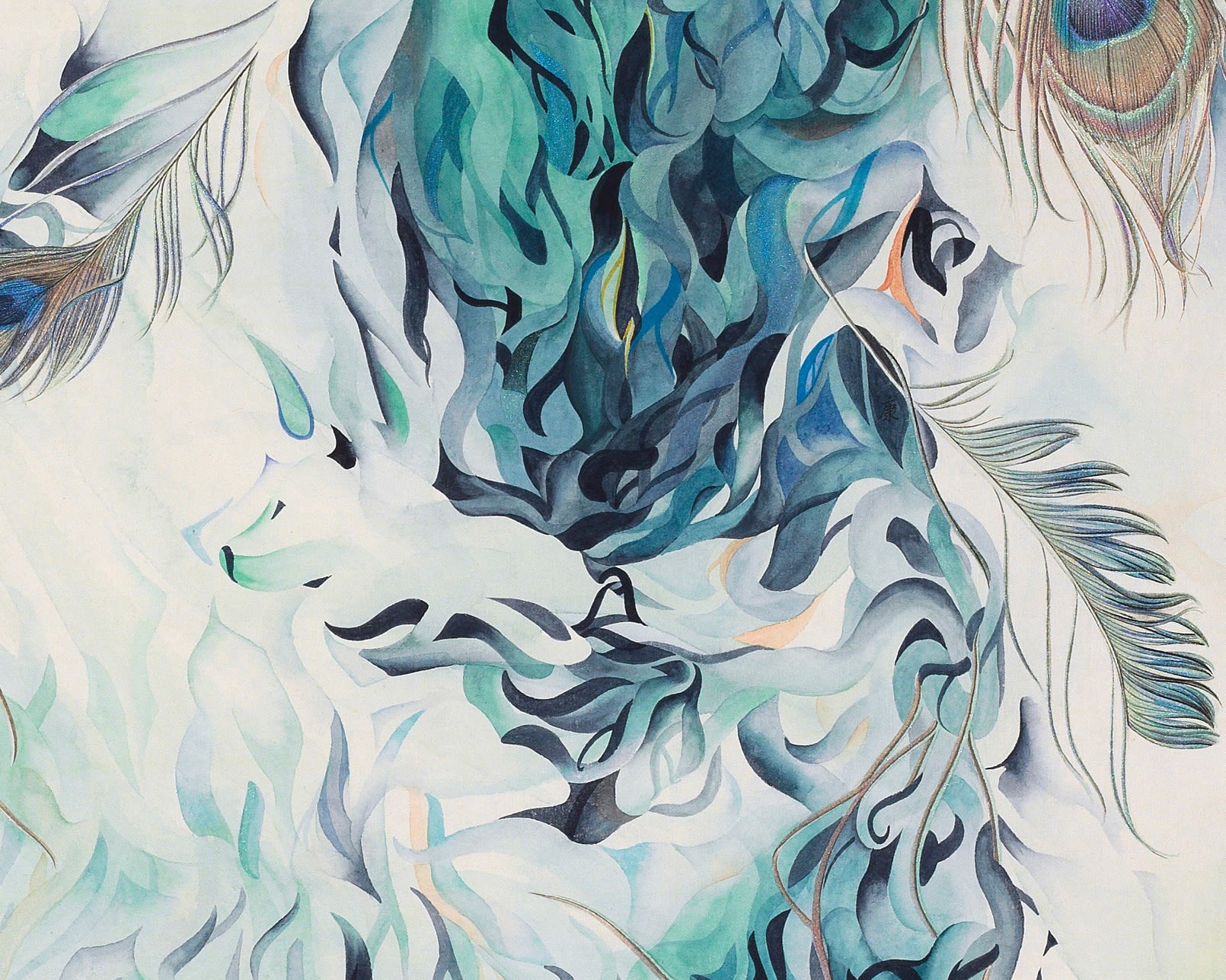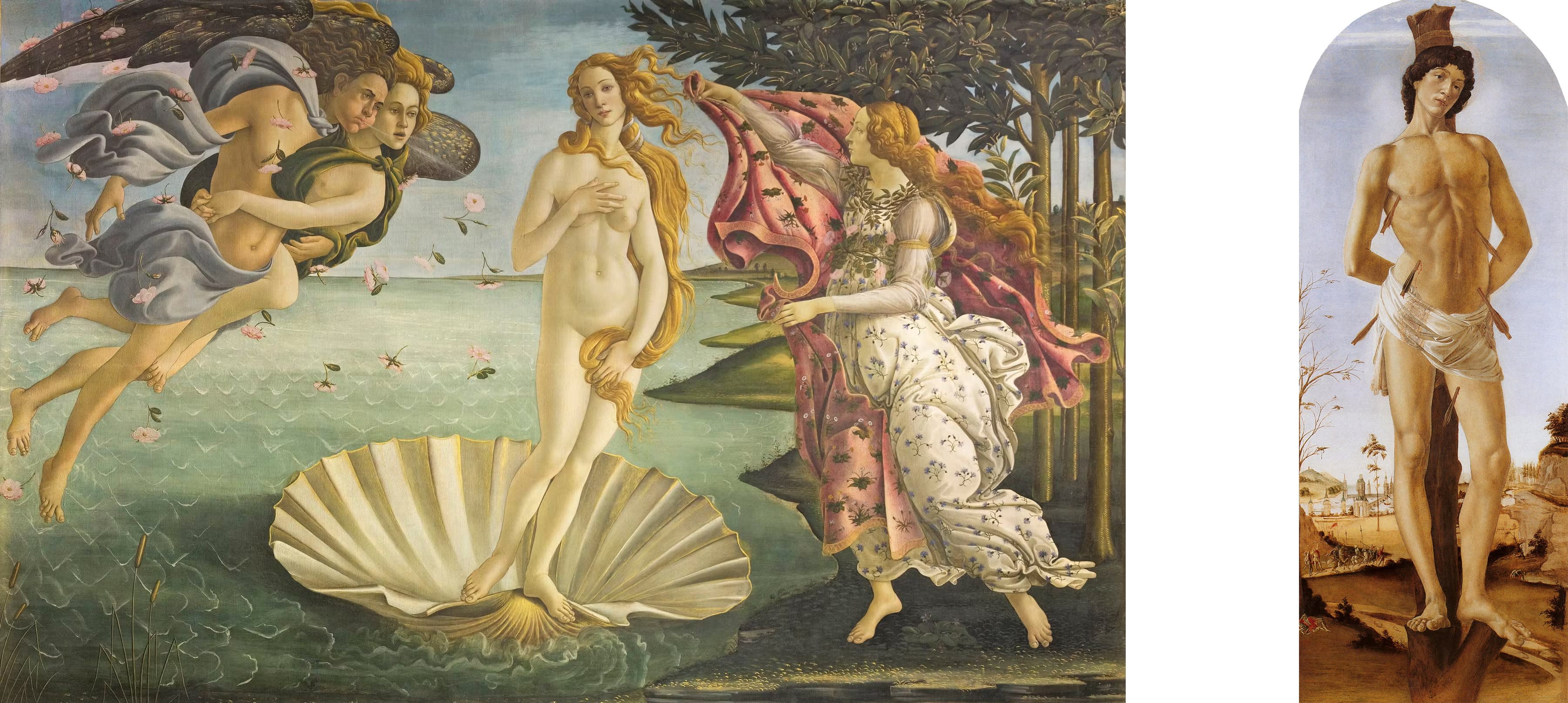For English scroll down.
%20隐逸的主角%20No.2%20(对屏画)_d01.jpg)

The Hidden Protagonist No.2 (diptych), detail, 2022-2024, Ink and mineral pigment on paper, 200 x 103 cm x 2
Started in 2022, prior to her journey to Xinjiang, the diptych The Hidden Protagonist No. 2 was completed in 2024 after three years of meticulous development. This monumental piece serves as a culmination of several recurring conceptual and structural themes within Kang Chunhui's oeuvre, drawing inspiration from diverse sources such as European mythology, formal transmutation, chromatic experimentation, and sacred architecture. The diptych presents two paintings arranged back-to-back, resembling sculptural pieces in the space. Their arched steles or altarpiece-like formation evokes associations with religious paintings commonly found in Buddhist caves or Western churches, albeit in contemporary renditions.
At first glance, the subjects of the two works, one predominantly infused with shades of green and blue, and the other with red and yellow, present themselves as semi-abstract, ethereal elements in motion. However, upon closer examination, discerning observers begin to identify standing human figures, one in each painting. Mirroring the formal transformations observed in Kang's recent works featuring bird figures, distinctive facial or other bodily features are deliberately left indistinct, revealing only the essential vitality of human existence - manifested as the representation of a man and a woman, respectively depicted in each painting. The inspiration for this piece is drawn from iconic pictorial references of the past, particularly Sandro Botticelli's renowned works such as "St. Sebastian" (1473) and "The Birth of Venus" (1484-1485).
What truly captivates Kang Chunhui is the depiction of the dynamic vitality of human nature rather than the specific identity of the subject. Venus embodies birth and life, while St. Sebastian personifies the figure of the dying martyr - one represents an unorthodox and enigmatic path to existence, while the other embodies the tragedy of sacrifice.
What's intriguing to note here is the criterion by which the artist selects her subjects. The renowned art historical reference serves as a tool to facilitate the progressive identification of a familiar subject through visually trained neural patterns, serving as a vehicle for the exploration of existential themes. According to Greek mythology, Venus-Aphrodite's birth is attributed to the foam created when Uranus's severed genitals were thrown into the ocean by his son Cronus. Already in an adult form, Venus emerged from this foam, symbolizing a break from destruction and the birth of freedom. This unique origin story underscores her significance in various cultural contexts. In Chinese classical literature, such as "洛神赋" (Luoshen Fu), which translates to "Ode to the Goddess of the Luo River," themes of femininity and physical form are explored, though often without a clear depiction of the female body, which disappears under the draping of the clothing.(1) In Kang Chunhui's perception, the Goddess of the Luo River embodies a poignant allegory akin to Venus, symbolizing personal feminine freedom and liberation.
In the case of the male figure, Kang chose to depict an emblem of sacrifice, a motif commonly found in Chinese literature. Unlike her method with Venus, she chose a Botticelli painting exploring sacrifice without the need for a specific figure. To maintain visual coherence, the artist unified the chosen figures for consistency in the artwork. As a Chinese counterpart, Kang Chunhui initially imagined representing the spirit of sacrifice via the depiction of the horses appearing in Six Steeds of Zhao Mausoleum from the Tang Dynasty, whose bodies were pierced by arrows similar to those of St. Sebastian.(2) In the portrayal of San Sebastian, embodying the essence of sacrifice, the six horses also symbolize this selfless act, offering themselves willingly for their master. In the final work, the arrows stuck out of St. Sebastian are exquisitely transposed as soft peacock feathers, a formal transformation that mitigates the pathos of the depicted scene.

波提切利《维纳斯的诞生》(左),《圣塞巴斯蒂安》(右)
Sandro Botticelli The Birth of Venus (left), Saint Sebastian (right)
(1),《洛神赋》是三国时期曹植(192-232)创作的著名辞赋。其中一幅为人熟知的《洛神赋图》手卷(宋代摹本)现藏于英国大英博物馆。
"洛神赋" ("Luoshen Fu") can be translated as "Ode to Nymph of the Luo River" or "Ode the Goddess of the Luo River". It's a famous Chinese poem written by Cao Zhi (AD 192-232) during the Three Kingdoms period. A well-known depiction of the story can be found in a handscroll painting from the Song Dynasty, currently held by the British Museum.
(2),《昭陵六骏》是最初位于中国陕西昭陵的六幅大型浮雕石刻,分别刻画六匹中箭的战马。昭陵是唐太宗(618-907)的陵墓。这些战马是唐太宗在早期统一中国时所骑的六匹珍贵战马。
The Six Steeds of Zhao Mausoleum are six Tang Chinese stone reliefs of horses that were originally located in the Zhao Mausoleum, Shanxi, China. The Zhao Mausoleum is the burial site of Emperor Taizong of the Tang Dynasty (618-907). The steeds were six valuable war horses ridden by Taizong during the early campaigns to reunify China under the Tang Dynasty.
